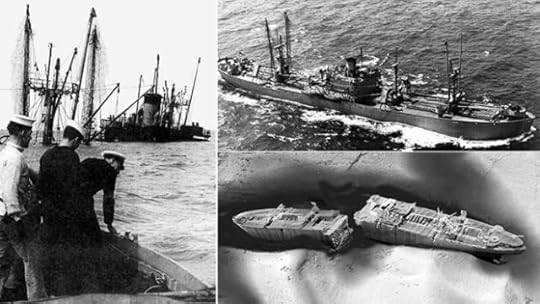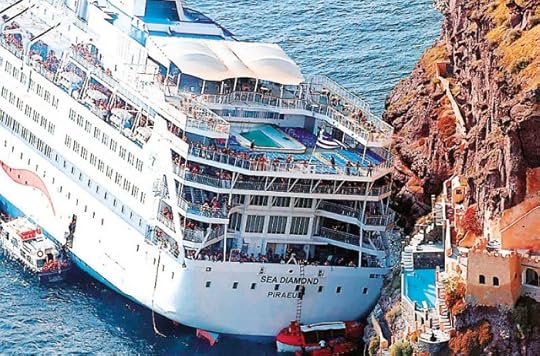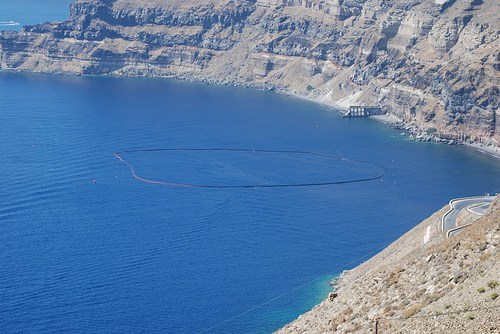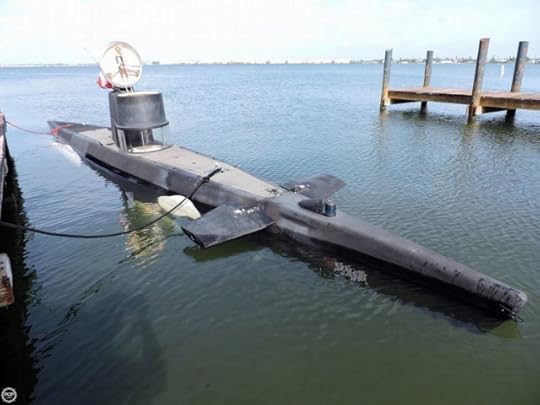Taylor Zajonc's Blog, page 5
May 11, 2016
Ships of THE WRECKING CREW: The Conqueror
 Ever wonder what ship inspired the Conqueror in the novel THE WRECKING CREW? Look no further than The World Is Not Enough, the fastest superyacht in the world.
Ever wonder what ship inspired the Conqueror in the novel THE WRECKING CREW? Look no further than The World Is Not Enough, the fastest superyacht in the world.
Built by Millennium Superyachts, the ship The World is Not Enough tops out at more than 70 knots / 80 miles per hour. She’s constructed largely of lightweight aluminum alloy and carbon fiber and propelled by more than 20,000 horsepower.
M/Y THE WORLD IS NOT ENOUGH
Model:
Millennium 140
Builder:
Millennium Superyachts
Naval Architect:
Mulder Design
Interior Designer:
Evan K Marshall
Year:
2004
Length Overall:
42.40m (139’1″ft)
Beam:
8.25m (27’0″ft)
Draft (max):
1.88m (6’2″ft)
Guests:
10
Crew:
6
Hull Material:
Aluminum
Superstructure:
Aluminum
Propulsion:
Triple Waterjets
Max Speed:
70 kts / 80 mph
Check out some excerpts from the novel below!
“Your ship won’t work.”
“But—” protested the doctor.
“There’s only one ship in the world that’s fast enough,” said Jonah. “And she ain’t for charter.”
“I’m afraid I’m in no position to purchase a yacht.”
“That’s fine,” smiled Jonah. “Because we’re going to steal it.”
The crown jewel of the collected ships gently rocked at the end of the long dock, as if every other yacht were but a court valet, and this the empress herself. Sleek lines suggested a vastly different intent of construction than the other bulbous, glitzy cruisers that surrounded it. This was not just any plaything of the ultra-wealthy; this was the Conqueror, the fastest superyacht ever constructed, a coiled spring, a loaded .357 magnum with a hair trigger. Her sleek 140-foot carbon fiber underhull gently rose and fell with the lapping waves, the moonlight glinting off the laminated strands of ultra-strong synthetics. The skin hid a true technical marvel of exactingly designed structural honeycombing, and her upper works were constructed of high-quality aluminum and ceramic composite, interrupted only by blacked-out lightweight privacy glass. Even while docked, her lines whispered sweet nothings of speed, a barely restrained surging velocity.
The indicators passed fifty knots, then sixty, before topping out almost to eighty. Even the untrained ear could hear the engines singing in beautiful harmony and rhythm, perfectly tuned, precisely attenuated for the task at hand. The howling engines drowned out all else but the starry night sky as Malta disappeared behind them.
“So tell me, what did you have against her previous owner?” asked the doctor.
“That’s a story for another day,” answered Jonah.
Want to read more? Check out THE WRECKING CREW today (Blank Slate Press, 2016).
May 9, 2016
Survivor-lead mountaineering trek visits 1972 “Alive” plane crash & cannibalism site
Looking to join a truly one-of-a-kind mountaineering trip? There may be no more unique treks than the survivor-lead expedition to the crash site of Uruguay AF Flight 571, the incident immortalized by the 1993 Ethan Hawk/John Malkovich film “Alive!”
Flight 571 was specially chartered to ferry 45 rugby team members and their associates across the Andes mountain range of South America. Departing from Montevideo, Uruguay, they’d never make it to their match in Chile. Beset by clouds, the pilots underestimated their distance from Santiago and began to descend into the mountains.
The pilots wouldn’t survive their error. Their Fairchild FH 227 first impacted a 13,800 foot outcropping with their right wing, completely tearing it from the body of the plane. A second peak tore off the other wing shortly thereafter, leaving the wingless fuselage to hit the ground and slid down the steep mountainside.
Crash Site: Google Earth
Though only a quarter of the passengers died in the initial crash, others soon began to die of their injuries and the cold, leaving just 27. Eight more were killed in an avalanche, and only sixteen would ultimately survive.
With little food, no firewood and living in the otherwise harsh conditions at 12,000 feet, the survivors were forced to eat parts of their deceased companions. After learning from their radio that the search had been ended, two men braved ten days of extreme conditions as they trekked down the mountain to notify authorities of the surviving passengers. The last of the passengers were rescued 72 days after the crash.
Want to see the site for yourself? Survivor Eduardo Strauch and Boulder, Colorado based Alpine Expeditions now offers regular yearly tours to the crash site, where much of the wrecked plane still remains.
About the Flight 571 Expeditions
Trailer for 1993 Film “Alive!”
May 8, 2016
Enter to win a signed copy of my novel!
I’m giving away two signed copies of my novel THE WRECKING CREW – enter to win below!
Goodreads Book Giveaway

The Wrecking Crew
by Taylor Zajonc
Giveaway ends May 15, 2016.
See the giveaway details
at Goodreads.
May 4, 2016
The Ticking Time Bomb of the Thames
Coastal cities around the world are accustomed to facing a variety of threats ranging from hurricane and tsunami to rising sea levels. But perhaps none face one so unusual–and potentially sudden–as those surrounding the Thames Estuary.
1944: The American-built “Liberty Ship” SS Richard Montgomery ran aground and partially sank while ferrying some 7,000 tons of bombs and other munitions to the UK. While the bulk of the explosives were removed, her cargo holds gave way and the ship broke apart, making it too dangerous to continue. Some 1,400 tons of TNT high explosives remain on board.
As the casings continue to rust and corrode and the explosives themselves chemically destabilize over time, experts have repeatedly warned that the entire cargo could detonate at any moment. External factors like collision, tide, a shifting of weight or even terrorist attack would only exacerbate the risk.
It’s not the first time the UK has dealt with a similar crisis. In 1967 salvors inadvertently set off the cargo of the sunken Kielce in the English Channel. The resulting explosion measured 4.5 on the Richter scale and created a 153 foot long crater in the ocean floor. Some believe that the Richard Montgomery poses a far greater threat, and could throw debris some 10,000 feet in the air and send a 16 foot high tsunami-like wave racing towards nearby towns.
While the wreck remains under 24-hour radar surveillance and is ringed by warning buoys, the site is far from shore. Last year a paddleboarder approached the wreck and was photographed touching one of the exposed forward masks. Authorities will continue to conduct regular inspections, but the official policy remains one of “Wait and See.”
May 2, 2016
Tourist Helicopters Are Newest Everest Avalanche Threat
Overcrowded Everest transit routes are facing a new threat – avalanches triggered by rogue tourist helicopters. “These sightseeing helicopters are hovering above the Khumbu Icefall,” said mountain guide Pasang Kaji Sherpa to BBC. “We worry that helicopters can crack ice blocks and snow packs on mountains overlooking the Khumbu Icefall. There is a deep-seated fear among Sherpa porters that they may be hit by avalances this year as well and these helicopters are increasing fears.”
This new fear may have been caused by good intention. Helicopters have been recently authorized to ferry equipment between Everest Base Camp (17,700ft) and Camp I (19,900ft), a practice that began in late April of 2016.
This logistical leapfrog theoretically reduces the risk to Sherpas by reducing their transits through the avalanche-prone Khumbu Icefall. Early data suggests each helicopter flight can save upwards of 15 trips by an individual porter.
There is good reason to limit trips through the icefall. One 2014 Khumbu avalanche alone claimed the lives of 16 porters.
However, it appears that some tour operators have now begun to treat confusion between logistical and sightseeing helicopters as a potential opportunity, bringing sightseers and tourists closer than ever to the famed mountain. The Civil Aviation Authority of Nepal admits that it has not yet cracked down on the practice, though their regulations do prohibit sightseeing flights above Base Camp.
Helicopters on Everest have a decidedly mixed track record. One flight crashed in 2010 while trying to save two climbers stranded at 22,494 feet. The pilot and onboard paramedic were killed. Other crashes have occurred at Everest base camp, including a 2003 incident that claimed two lives. A controversial record was set in 2005 when french pilot Didier Desalle landed a Eurocopter AS350 atop the summit.
The Airlines Operators Association of Nepal (AOAN) has publicly defended the practice against their detractors.
“We fly 2,340 feet from above the ground and maintain at least 1km distance from the mountains so there is no way the vibration can cause avalanche,” said Pabitra Karki, chairman of Airlines Operators Association Nepal.
Perhaps he is correct, only time will tell. In the meantime, these sightseeing flights will continue to gamble with the lives of porters and climbers alike.
April 21, 2016
Early Everest Chaos Warns of Deadly 2016 Season
It was once thought that the 1996 Mount Everest climbing season represented the mountain at it’s worst–overzealous guides, inexperienced climbers, overcrowded routes, poorly coordinated expeditions, all amounting to a disaster waiting to happen. The staggering fifteen climbing deaths that year were a watershed moment as the world absorbed the event through news reports and author Jon Krakauer’s mega-hit Into Thin Air. Climbers and Everest-watchers alike reflected on the high toll, leading many to assume that the age of Everest irresponsibility had finally come to an end.
However, it’s increasingly beginning to appear that 1996 may only be a footnote as deaths continue to mount. The climate-change wracked south (Nepalese) side seems increasingly prone to avalanche with each passing year. A record 19 climbers perished in 2014, followed by 25 the following year, marking the first season in 41 years where not a single climber made it to the summit.
The early chaos of the 2016 Everest climbing season hints at yet another deadly year. Unseasonable warmth makes for poor ice, and avalanche-prone conditions are forcing more and more climbers to the difficult north (Tibetan) side of the mountain and onto routes they may not be technically prepared for. Making matters worse, there is no helicopter rescue landing zone on the Tibetan side. This means climbers are forced to rely on each other in the case of emergency, a dim prospect in the self-reliant world of mountaineering. The aborted 2015 season may mean a level of “bottled-up” demand, and even more mountaineers fighting their way to the top than usual.
Danish mountaineer Ivan Braun has already called off his expedition for now, saying he may try again in the fall, stating that the risk of accident is simply too high to attempt during the spring. Only time will tell if other climbers do the same.
April 20, 2016
UPDATE: 12-Year Old Mountaineer Denied Everest Permit
In unsurprising news, 12-year-old mountaineering wunderkind Tyler Armstrong has been denied a rule-exempted permit to climb Mt. Everest’s highly technical north side in an effort to become the youngest climber to successfully reach the top of the “Seven Summits.” Current Chinese laws deny Everest climbing permits to individuals under 18 years of age. Tyler is running out of time; the current record was set by then 13-year-old American Jordan Romero, a record likely to stand indefinitely given the new law.
I am re-posting my original blog entry on this below. Again, I call on readers to respectfully tweet, Facebook or email Debra Miller, CEO of national Muscular Dystrophy nonprofit CureDuchenne to pull support from this irresponsible, foolhardy campaign. No amount of fundraising dollars is worth such grave risk to a young persons’ life, however exceptional that young person might be. Perhaps better decisions might be made regarding young Tyler Armstrong’s climbing career once the pressure to set a record is lifted.
11-year-old mountaineer Tyler Armstrong is no doubt an exceptional young man. On August 12, he announced via press release he had completed a mountaineering expedition to the summit of Russia’s Mt. Elbrus, which at 18,510 feet in height is the tallest peak in Europe. It was a third victory in his effort to become the youngest person to climb the “seven summits,” the tallest peaks of every continent.
Young Tyler Armstrong now hopes to climb Mt. Everest in 2016 as part of a campaign to raise $1 million for a Muscular Dystrophy charity. While this goal is commendable, sending an 12-year-old boy to the tallest peak in the world reeks of irresponsibility.
The truth is we don’t know what prolonged hypoxia does to a developing brain. In addition, the toll of Mount Everest is as staggering as it is well documented–just this year, 19 people died and 61 were injured in an avalanche set off by the Nepalese earthquake. And though this doesn’t speak to Tyler’s immediate safety, the undue risks (and frequent death) faced by Sherpa guides and porters are now widely condemned.
Children can become injured or die chasing records just as easily as grownups. In 2000, previous Mt. Everest youngest climber record-holder Temba Tsheri lost five fingers to frostbite while climbing the southern route. British Mountaineering Council medical adviser David Hillebrandt called Jordan Romaro’s record-setting 2010 climb of the peak (at age 13) “…totally against the spirit of true mountaineering… about mass marketing, money and it’s verging on child abuse.” When taking a direct question from Tyler Armstrong on HuffPost Live, legendary outdoor author and Everest veteran Jon Krakauer told the boy to “think twice,” and that his own Everest climb was the “biggest mistake” of his life.
The history on young aspiring record-setters is clear. In 1996, 7-year-old Jessica Whitney Dubroff died in an air crash 24-hours into her attempt to become the youngest person to fly across the United States. In 2014, 17-year-old Haris Suleman crashed his plane into the Pacific Ocean while attempting to set an around-the-world flying record for charity. The World Sailing Speed Council (WSSRC) no longer ratifies claims of the record-setting youngest sailors after a series of increasingly young contenders; unrecognized attempts continued and included Abby Sunderland, a 16-year-old Californian who was dismasted and left adrift in a remote part of the Indian Ocean for days before her eventual rescue. For these boys and girls, it was too much too soon; inexperience combined with the bad fortune that inevitably plagues dangerous pursuits.
This opinion may come across as hypocritical to some. At 19 years old I became the youngest person to dive aboard a manned submersible to a depth of 16,700 feet below the surface of the ocean. (As an aside, I’ve been waiting for the awkward conversation when someone tells me this record has been broken or was never mine to begin with for the past fourteen years.) But 19 is very different than 11 or 12; not only did I know the risks, the risks were minor compared to the yearly toll of Mt. Everest and other extreme peaks.
It’s time for the mountaineering community to draw an ethical line in the sand. A 12-year-old has no business on Everest, and no credible guiding agency should take on such a young client, no matter how exceptional the person or circumstances. Further, national Muscular Dystrophy nonprofit CureDuchenne must pull support from this irresponsible, foolhardy campaign. (Tweet to them here! Facebook to them here!) No amount of fundraising dollars is worth such grave risk to a young persons’ life. Tyler Armstrong should have a lifetime of pursuing adventure and good causes, and not risk it all at such a tender age.
April 7, 2016
Santorini’s Pending Environmental Disaster
Raising the Coasta Concordia from the waters of Italy’s Giglio Island cost an estimated $2 billion dollars. But now experts, environmentalists and residents of Santorini, a popular Greek holiday destination, are calling for the same scale of operation for the MS Sea Diamond, a 470 foot cruise ship lost off the island in 2007 after striking a well-known volcanic reef.
Some 1,195 passengers (largely American and Canadian) and 391 crew were evacuated, though two french passengers died. Damage control teams were unable to save the Sea Diamond, and the ship turned over and sank over a steep-sloped ocean bottom. Her bow now rests in 200 feet of water (approximately the same depth as the Costa Concorida) but her stern reaches a depth of nearly 600 feet.
Now lost for nearly ten years, the head of the Crete-based monitoring team has warned that hull degradation has increased the level of fuel and engine oil escaping from the wreck to an “alarming” rate, potentially overwhelming the inflatable floating berm designed to capture the runoff. A slow-motion environmental disaster may now been in the works.
“The rudimentary pollution barrier that has been placed at sea level is not adequate to collect all the substances that are being released. If the ship is left as is, a biological disaster will befall the caldera. Something needs to be done at once.” – Evangelos Gidarakos, Technical University of Crete
But any recovery of the wreck itself will not be easy. She sits atop a steep volcanic slope, and any removal of buoyant fuel may disturb her from her current resting place. Given her steep angle, any recovery operation may represent an effort of vastly greater expense and complication than her recently-recovered counterpart.
Challenging logistics aside, Santorini mayor Nikos Zorzos is insisting on a solution. “People are concerned,” he said. “They want a solution. Anyone opposed to raising the wreck needs to come up with an alternative, not just leave it there.”
With the MS Sea Diamond just one of thousands of similar wrecks across the world, a better system of monitoring and remediation has become increasingly critical. A sunken oil-carrying barge in Lake Erie forced an emergency investigation, and there are no doubt many more unknown shipwrecks that pose comparable dangers.
April 6, 2016
Psst … wanna buy a submarine?
Looking for a bargain submarine? Check out the 32-foot diesel-electric “Marlin”, perhaps the cheapest one-atmosphere sub on the market, now available for the rock-bottom price of $225,000. Built in 1987, she boasts a 200-mile range, “intuitive controls”, and a maximum recommended operating depth of 300 feet. She’ll carry two people and their equipment for up to 72 hours with onboard life support systems, oxygen supply and CO2 air scrubbers.
Not surprisingly, this submarine has had a long, strange journey through multiple owners over the past 29 years. She was originally built by US Submarines, Inc. for the Swedish Navy as a training stand-in for Soviet mini-subs before she was sold to radical environmental activist group Sea Shepherds in 1998.
The Sea Shepherds intended to deploy her against the Makah Tribe’s annual whale hunt, exchanging the submarine’s yellow paint job for an orca-like color scheme by artist George Sumner. The activists intended to scare any gray whales from Neah Bay using underwater speakers and sounds of gray whales being attacked by orca whales.
The Canadian Navy disapproved of the purchase, saying “no one at Sea Shepherd knew anything about operating a submarine and it was ridiculous for Sea Shepherd to acquire one.”
In his typically bombastic fashion, Paul Watson with a now-famous retort, saying, “Since World War II, the Sea Shepherd Conservation Society has boarded more ships, rammed more ships, engaged in more high seas confrontations and sunk more ships than the Canadian Navy.” But despite his words, the submarine was ultimately only used as an expensive deck prop and sold just a year later.
With the exception of some test dives in Washington and Florida, it appears the Marlin hasn’t done much in the last 17 years. She had one final brush with fame in 2013, playing a narco-sub on the now-canceled television show “Graceland” (USA Network), but little else in the way of regular use beyond test dives in the waters off Washington and her new home in Florida.
So … you wanna buy a submarine?
March 29, 2016
Seeking St. Johns & NoPo Authors
 Courtesy Andrea Zajonc Photography
Courtesy Andrea Zajonc PhotographyWith the untimely shuttering of St. Johns Booksellers, it’s become more important than ever that we come together to celebrate our community authors and readers. What better way to do that than a neighborhood author event?
If you’re a published author living in St. Johns/NoPo (or know one), please take a moment to reach out to me at taylor@expeditionwriter.com. I’d love to see if we can organize a fun, informal event sometime this summer to celebrate our community writers and readers alike.
I know for a fact that we have a huge number of avid local readers! I see more “Little Free Libraries” every time I walk my dog. I’d love to see if anyone else is interested, and I look forward to meeting more of you soon!





























